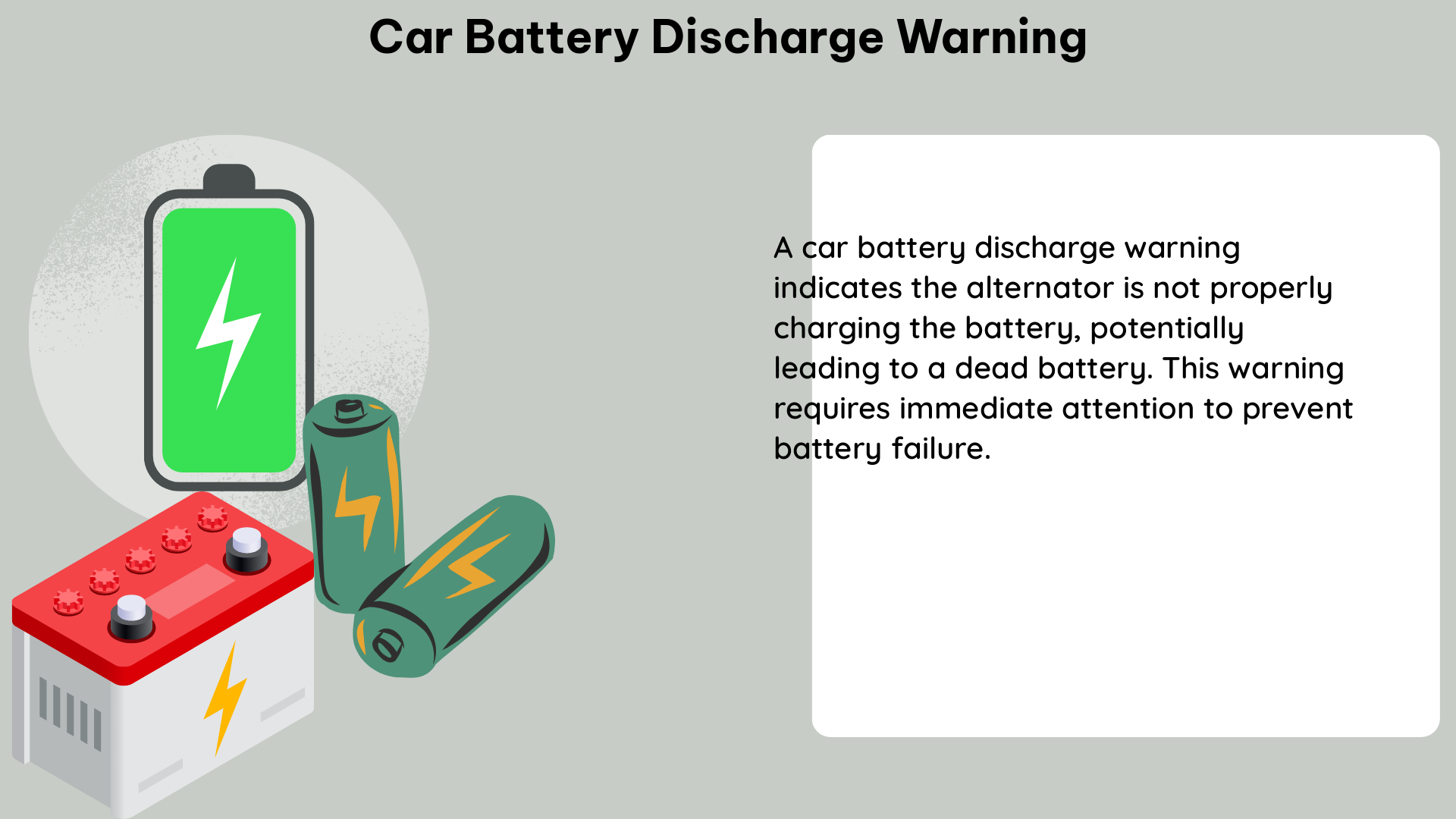A car battery discharge warning is a critical indicator that the vehicle’s battery is draining faster than it is being charged, potentially leaving the driver stranded. This warning is designed to prevent the battery from running out of charge, which can leave the driver unable to start the vehicle later on. The warning light may appear on the instrument panel or on the infotainment system, depending on the vehicle manufacturer.
Understanding the Causes of Car Battery Discharge Warning
The car battery discharge warning light may come on for several reasons, including:
- Electrical Component Usage with Engine Off: Using electrical components like the radio, infotainment system, or interior lights when the engine is turned off can quickly drain the battery, triggering the warning light.
- Old or Faulty Battery: As car batteries age, their ability to hold a charge diminishes, leading to a faster discharge rate and the activation of the warning light.
- Leaving Lights On Overnight: Forgetting to turn off the headlights, interior lights, or other electrical components can cause the battery to drain overnight, resulting in the warning light.
- Extreme Temperatures: Extremely cold or hot temperatures can affect the battery’s performance, leading to a faster discharge rate and the activation of the warning light.
- Short Drives: Frequent short drives, where the engine doesn’t run long enough to fully recharge the battery, can also trigger the battery discharge warning light.
- Faulty Alternator: A malfunctioning alternator that is unable to properly charge the battery can cause the battery to discharge, leading to the warning light.
Identifying the Underlying Issue

When the battery discharge warning is triggered, it’s essential to diagnose the underlying issue to prevent further battery drain and potential vehicle failure. Here are some steps to identify the problem:
- Check Battery Connections: Ensure that the battery terminals are clean and properly connected. Loose or corroded connections can prevent the battery from charging correctly, triggering the warning light.
- Test the Battery: Use a voltmeter to measure the battery’s voltage. A healthy battery should read between 12.6 and 12.8 volts when the engine is off and between 13.5 and 14.5 volts when the engine is running. If the voltage is outside of these ranges, the battery may need to be replaced.
- Inspect the Alternator: A faulty alternator that is unable to properly charge the battery can cause the battery discharge warning to activate. Use a voltmeter to test the alternator’s output voltage while the engine is running. The voltage should be between 13.5 and 14.5 volts.
- Identify Electrical Drain: If the battery is discharging even when the vehicle is not in use, there may be an electrical drain caused by a malfunctioning component or a parasitic load. Use a multimeter to measure the current draw with the engine off and all electrical components turned off. The current draw should be less than 50 milliamps.
Resolving the Car Battery Discharge Warning
Once the underlying issue has been identified, you can take the necessary steps to resolve the car battery discharge warning:
- Charge the Battery: If the battery discharge warning is caused by insufficient charge, let the vehicle run for about 45 minutes to an hour to allow the alternator to recharge the battery.
- Replace the Battery: If the battery is old or faulty, it may need to be replaced. When replacing the battery, ensure that the new one is compatible with your vehicle and has the same or higher cold cranking amps (CCA) rating.
- Fix Electrical Connections: If the battery connections are loose or corroded, clean the terminals and ensure that they are properly tightened.
- Repair or Replace the Alternator: If the alternator is not properly charging the battery, it may need to be repaired or replaced.
- Identify and Eliminate Parasitic Loads: If there is an electrical drain on the battery, use a multimeter to identify the source and disconnect or repair the malfunctioning component.
Preventive Measures
To prevent the car battery discharge warning from occurring in the future, consider the following preventive measures:
- Regular Battery Maintenance: Regularly clean the battery terminals, check the battery’s charge level, and replace the battery if it’s old or faulty.
- Avoid Excessive Electrical Usage with Engine Off: Minimize the use of electrical components like the radio, infotainment system, and interior lights when the engine is turned off.
- Ensure Proper Alternator Function: Have the alternator tested periodically to ensure it is properly charging the battery.
- Avoid Short Drives: Try to take longer drives to allow the alternator to fully recharge the battery.
- Monitor Battery Discharge: Keep an eye on the battery discharge warning light and address any issues promptly to prevent further battery drain and potential vehicle failure.
By understanding the causes, identifying the underlying issues, and taking the necessary steps to resolve the car battery discharge warning, you can ensure your vehicle’s electrical system is functioning correctly and prevent unexpected breakdowns.
Reference:
- What Does a Battery Discharge Warning Mean? Meaning and Troubleshooting Tips
- Battery Discharge Warning: All Things You Want to Know
- Why am I getting a ‘battery discharge’ warning on my car’s dashboard?

The lambdageeks.com Core SME Team is a group of experienced subject matter experts from diverse scientific and technical fields including Physics, Chemistry, Technology,Electronics & Electrical Engineering, Automotive, Mechanical Engineering. Our team collaborates to create high-quality, well-researched articles on a wide range of science and technology topics for the lambdageeks.com website.
All Our Senior SME are having more than 7 Years of experience in the respective fields . They are either Working Industry Professionals or assocaited With different Universities. Refer Our Authors Page to get to know About our Core SMEs.